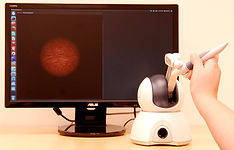RESEARCH
Haptography: Capturing and Recreating the Rich Feel of Real Surfaces
Haptography, like photography in the visual domain, enables us to quickly record the haptic feel of a real object so that the sensations can be reproduced later. We capture the haptic signals by using a custom haptic recording tool that is used to measure the forces and high-frequency vibrations felt when interacting with textured objects. The vibrations felt by the pen when it is dragged across the object encode information about the object's texture and roughness. We create mathematical models of these signals, which are then stored and used to create virtual versions of the objects later. During rendering, we attach a voice coil vibration actuator to a stylus, which is used to output the texture vibration signals as the user drags the stylus across the tablet surface.
The Penn Haptic Texture Toolkit
The Penn Haptic Texture Toolkit (HaTT) is a publicly available repository of haptic texture models for use by the research community. The toolkit includes 100 haptic texture and friction models, the recorded data from which the models were made, images of the textures, and the code and methods necessary to render the textures using an impedance-type haptic interface such as a SensAble Phantom Omni. This toolkit was developed to provide haptics researchers with a method by which to compare and validate their texture modeling and rendering methods. Furthermore, the included rendering code allows both researchers and designers to incorporate our texture into their virtual environments, which can lead to a richer experience for the user.



Haptic Guidance for Ultrasound-Based Instrument Guidance
In ultrasound-assisted needle insertion tasks, clinicians use an ultrasound probe to image a point of interest under the skin (e.g. a tumor), and then must use the ultrasound image to properly insert a needle into the target location. This highly spatial task requires clinicians to align the needle trajectory with the ultrasound plane and the target location while simultaneously ensuring that the ultrsound plane remains aligned with the target. Our research seeks to use haptic feedback to alleviate some of the cognitive load from the clinican by providing simple and intuitive feedback to the ultrasound probe if they begin to slip off of the target. Our haptics works in tandem with a visual guidance system, the Clear Guide One, the provides visual feeback to help the clinician align the needle with the target. Our current haptic guidance system consists of two vibration actuators that are mounted on the sides of the ultrasound probe to provide feedback to correct unintentional probe tilting. We are exploring additional haptic feedback modalities that allow us to correct mulitple degrees of error.


Ungrounded Haptic Feedback through Asymmetric Vibrations
Humans perceive an ungrounded pulling sensation when subjected to asymmetric accelerations at the fingertips. These asymmetric accelerations are created using a voice coil actuator, which consists of a magnet suspended inside an electromagnetic coil. Current pulses used to drive the electromagnet push the magnet quickly in one direction and allow the magnet to slowly return to its starting position. This asymmetric motion of the magnet creates large position peak forces and low negative peak forces, which results in a net pulling sensation. When the actuators are held, these forces are translated to skin deformation at the user's fingertips. This strong kinesthetic cue can be used to provide directional guidance to a user.


